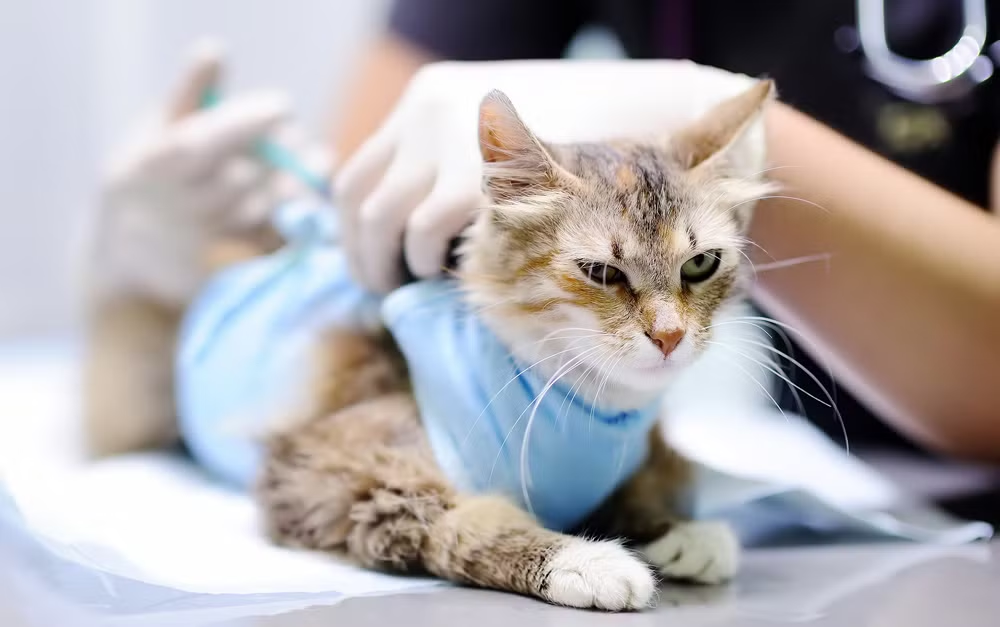
Feline panleukopenia, also known as feline distemper, is a highly contagious and often fatal viral disease that affects cats worldwide. Caused by the feline parvovirus, it primarily targets rapidly dividing cells in the body, such as those in the bone marrow, gastrointestinal tract, and developing fetuses.
This article explains what feline panleukopenia is, its symptoms, diagnosis, and the importance of vaccination for prevention.
What is Feline Panleukopenia?
The term panleukopenia translates to “a decrease in all white blood cells.” Since white blood cells are vital for immunity, cats with feline panleukopenia become extremely vulnerable to infections.
Although it is commonly referred to as feline distemper, it is not the same as canine distemper. Instead, feline panleukopenia is closely related to canine parvovirus, as both belong to the parvovirus family.
How Feline Panleukopenia Spreads
Feline panleukopenia is extremely resilient in the environment. The virus can survive for up to a year on surfaces and is resistant to many common disinfectants. It spreads through:
Feces, urine, and nasal secretions
Contaminated food and water bowls
Shared bedding, cages, or litter boxes
Direct contact with infected cats
Outdoor and feral cats are at the highest risk due to environmental exposure.
Symptoms of Feline Distemper
The severity of feline panleukopenia depends on the age and health of the cat. Kittens are most at risk, with mortality rates extremely high if untreated.
Common symptoms include:
Fever and lethargy
Vomiting and severe diarrhea
Loss of appetite and dehydration
Sudden drop in white blood cell count
Neurological issues in kittens (cerebellar hypoplasia)
Vision impairment or blindness in severe cases
Pregnant cats infected with feline distemper may miscarry, deliver stillborn kittens, or give birth to kittens with lifelong neurological problems.
Diagnosis of Feline Panleukopenia
Veterinarians diagnose feline panleukopenia through:
Blood tests showing low white blood cell counts
ELISA tests detecting feline parvovirus antigens
Evaluation of clinical symptoms
Because symptoms can overlap with other feline diseases, proper testing is essential for confirmation.
Treatment and Supportive Care
There is no specific antiviral treatment for feline panleukopenia. Care is focused on supportive therapy to help cats survive the infection.
IV fluids to combat dehydration
Anti-nausea and anti-diarrheal medications
Antibiotics to prevent secondary bacterial infections
Nutritional support and careful monitoring
Kittens under 8 weeks often do not survive the disease, but adult cats have a better prognosis if treated early.
Prevention Through Vaccination
The feline distemper vaccine is the most effective way to protect cats against this deadly virus. Kittens should begin their vaccine series at 6–8 weeks of age, followed by boosters. Adult cats need regular vaccinations every 1–3 years, depending on veterinary guidance.
While vaccines are not 100% foolproof, vaccinated cats who contract the virus typically experience much milder symptoms.
Final Thoughts
Feline panleukopenia is one of the most dangerous viral diseases in cats, but it is also one of the most preventable. By vaccinating your cat, practicing good hygiene, and minimizing exposure risks, you can dramatically reduce the chances of infection.
For more detailed information on feline distemper and vaccination guidelines, visit the American Veterinary Medical Association (AVMA).